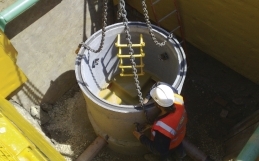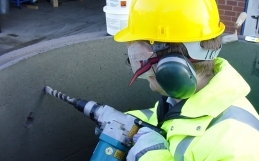Steps
BS EN13101:2002 Steps for underground man entry chambers. Requirements, marking, testing and evaluation of conformity

Steps shall be made from:
a) aluminium alloy to EN573:3 designation 6 060 or 6 106
b) cast iron – malleable conforming to EN1563 cast iron – spheroidal graphite (ductile) cast iron to EN1563 cast iron – flake graphite (grey) cast iron to EN1561
c) steel – to EN10025 or ENV10080 steel – austenitic stainless steel to EN10088-1 or EN10088-3, minimum grade X6CrNiTi18-10

Type D plastic encapsulated double steps are generally preferred. They are specified due to their high visibility, corrosion protection and durability
In most UK areas, single steps are not allowed. Single steps are considered less safe and those made from cast iron are prone to corrosion and increased risk of failure.
Steps are usually specified for manholes with a depth up to 3.0m from cover level to the soffit of the pipe.
Ladders
BS EN14396:2004 Fixed ladders for manholes

Ladders are usually specified for manholes with a depth between 3.0m – 6.0m from cover level to the soffit of the pipe.
Steps and Ladders
Many designers and asset owners specify products that comply with the relevant Standards, sometimes with further requirements for CE marking, Kitemarking etc to assure reliable manufacture and product quality. The purchase decision is left to the installer. Products that comply with such Standards meet a minimum requirement and are intended to provide assurance that the construction is completed using components of an acceptable quality to satisfy the design specification.
In the United Kingdom, there are harmonised product Standards relating specifically to manhole steps and to fixed ladders. There are also Standards and industry specifications relating to manhole assemblies and Standards relating to complete drainage systems where requirements for manhole steps, ladders and associated access systems are included in the specification. For innovative products that fall outside the scope of these Standards, independent assessment and third-party certification is advised.
The requirements in some industry specifications may demand different values for steps and ladders than the minimum requirements of the product Standard; these can be more onerous than the product Standard or they can be less demanding. Industry specifications are also sometimes inconsistent with each other and it can be confusing trying to decide on a suitable value to apply to a design. In these situations, it is advisable to consult the contract documents and confirm with the client which specification should take precedent.
Standard Caswick steps and ladders comply with the relevant product Standards and carry CE marking and Kite marking accreditations where appropriate. Generally, Caswick steps and ladders perform above the minimum requirements of the product Standard.
Designers, developers and asset owners beware.
There is a spectrum of quality, even for product Standard-compliant products. Those that only marginally conform to minimum requirements can result in lower long term performance over the manhole asset lifetime.
In the case of steps and ladders, this could compromise safety and result in higher whole life (totex) costs when compared with products of a superior quality that have the potential to perform better, for longer.
Manholes are dangerous underground confined spaces. Only authorized personnel should have access with the knowledge, equipment and the security means to carry out relevant inspection and maintenance work. In the vast majority of cases, access is made once or twice a year for routine maintenance. Sometimes chambers are not visited for years, only when an incident occurs.
When the manhole cover is lifted, the steps or ladders found were probably installed when the system was built. Each step inside the chamber can be a leap of faith. Even for Standard-compliant products, over time steps and ladders made from lower quality materials may place operatives at higher risk. Deterioration is progressive; the risks may not be immediately apparent, but can become evident with age. Exceedance of minimum Standard requirements can therefore provide “future-proofing” to ensure satisfactory long term performance.
The steel used for Caswick manhole steps is high tensile steel to BS EN10305 Steel tubes for precision applications. It is the Standard for cold drawn steel tubes of circular cross section. The advantage of steel tubes for precision applications is the high accuracy of their manufacturing, the good quality of their surface and the guaranteed mechanical and technological properties.
that is why the tubes are widely used in the machining industry and in the automotive industry.
Lower quality steps are not made from high tensile steel and do not provide the same degree of dimensional stability and robustness.
Most Water Undertakers prefer plastic encapsulation for enhanced durability and corrosion protection. Standard Caswick manhole steps use a special grade Polypropylene encapsulation which provides greater protection from impact, mechanical and thermal stress cracking and ageing. The actual thickness of the plastic encapsulation for Caswick steps is generally in excess of 4 mm compared with a minimum requirement of 2.5mm (BS EN13101).
These factors are important because plastic becomes brittle and as it ages cracks can appear in the encapsulation. This can expose the metal underneath and lead to corrosion and potential failure of the step, over time.

